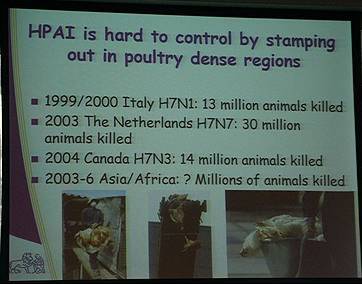|
White
Australorp bantams, The Netherlands. Photos: Klaas v.d.
Hoek
Here follows some Australian points of view on the
white Australorp:
From: Ross Summerell, National Secretary
"Australorp Club of Australia Inc."
At this
stage I have never seen a Large White Australorp, only the bantam variety;
however I am aware of four members of our club who are trying to develop
them for show quality.
I have
many old photographs in our archives of White Australorp Large Fowls that
were judged at both Brisbane and Sydney Royals in the late 1940’s and early
1950’s. The late Athol Giles commented on these fowls and said something
like they are perfect Australorps except for the solid white in feather.
These birds are still around on farms in Western Qld and it is this
foundations stock in large that the breeders are working on. I think that
the breeders take the task very seriously, and hopefully they will succeed.
With
respect to the British reference, we are Australian, we are not British and
we breed Australorps, not Orpingtons. It was Australian breeders who
developed the fowl initially, but you already know that.
Those
standards were made up by the club to get as close to a Black and Blue
Australorp as possible. We have at least 200 white birds on the ground now
and although they are considered rare, that is the colour points for the legs
etc. that the breeders decided on.
Please
find enclosed our Suggested Standard for the White Australorp. We certainly
have not followed the Orpington and red eyes and whitish legs are not
within the proposed standard.
Hope
this helps,
Regards,
Ross Summerell.
www.australorps.com
|
Suggested Standard for White Australorp Large & Bantams
for consideration by Australorp Club of Australia Inc.©
Type, carriage, head, neck, legs plus quality and type of plumage exactly
as in the Standards for the Black and Blue Australorp Bantams.
Weights to be the same as the new Standard of Weights for Bantam
Australorps.
Colour:
Pure White Free from straw tinge or
brassiness
Beak: Blue-ish White, Slate tones or Off-White (Horn)
Eyes: Black or Dark Brown, Black preferred. It is essential that
the eyes are large and bold.
Comb: Wattles and ear lobes Bright Red
Face: Bright Red preferred, to achieve dark eyes in females.
A little sootiness is allowed
Legs and Feet: Slate Blue
Soles of Feet: White
Toe Nails: White
Skin: White
Scale of Points:
Type and Carriage 30
Colour and Plumage 25
Head
(eyes 15 and,
face-comb-wattles 10 ) 25
Condition 10
Legs and Feet 10
____
100
====
Serious Defects: Suggest birds not to be
judged.
Red Eyes
White and/or Red-Yellow Legs
Same other serious defects as for the
Standards in Black and Blue Australorp Bantams.
|
|
 
|
 
|
|
Above text and photos: © copyright of the
Australorp Club of Australia Inc.
|
|
|
Reaction from Greg Davies:
White
Australorps-what should they look like?
Let me
clarify my beliefs on this issue:
· Whether we like to admit it or
not, Australorps ARE descended from Cook’s Orpington line (not the fluffy Partington
strains that were useless as utility fowls). As such, there is not one
other British-style breed that has white plumage with anything but white
legs and red eyes… in fact, the only breeds I can think of that have dark
legs/eyes and white feather are the Asiatic Langshans. While I understand
the point of view being Australian and not British, I must point out that
the original Australorp was most certainly founded on British Orpington
lines. Therefore, all our Australorps should… indeed MUST… carry Orpington
blood in some degree; otherwise they simply cannot BE Australorps.
· There can be no doubt that the
Australorp was pretty much what Cook envisaged (the woodcuts in his book,
“Fowls for the Times” certainly look a lot like Australorps). Cook’s idea
was to create a breed that was of wonderful utility usefulness but would be
easy to breed true. Anybody who has ever kept fowls will tell you it is
next to impossible to breed white feathered, dark-legged fowls true over
any number of years without sooty undercolour or gypsy faces coming in. It
is a genetic necessity for this to happen. The Australorp was deemed the
greatest utility fowl, not only for its usefulness, but for the fact that
it bred true, year after year after year… the indicator of a perfect
utility breed. These dark-legged whites are NOT going to breed true and as
such, will have forfeited one of the Australorp’s greatest foundation
traits. In short, the whites will NOT be a true utility fowl.
· To say that the dark legs in
whites are truest to the Standard is somewhat misleading. Most breeds that
have black and white varieties have different colour points in this area…
Minorcas, Naked-Necks, Orpingtons, Spanish and Faverolles, but to name a
few. Again, all of these breeds were, at one time, wonderful utility
breeds. Obviously, the originators of these breeds did not try to make all
colours the same with regards legs and eyes. They knew that it could not be
done successfully. Even our own Australian Game calls for leg colour to
match the plumage.
· The proposed standard is in
itself, contradictory. One of the crowning features of all Australorps is
the lovely, open red face, yet the standard for these whites allows for an
amount of gypsy colour. If the plan is to make the whites as close as
possible in all things, apart from plumage colour, to the blacks, then will
sooty faces become acceptable in Blacks? As I see it, we can’t have it both
ways… either we make the White standard exactly the same for Blacks allowing
for colour, or we look back to our history books and see what our
forefathers did when they made up most of the really great old breeds and
why they did it. There were good reasons why they made things the way they
did… they were concerned mainly with productive fowls that bred good and
true year after year. And they did it very, very well!
To
summarise, the Australorp is a direct descendant of Cook’s Orpingtons, and
as such should be standardised under the same colour patterns (whether or
not it galls us to admit the Poms were right). To try to breed a colour
that is next to impossible to achieve true over generations, is folly, and
the old-timers who perfected our utility breeds realised it then, just as
we should recognise their knowledge now. I reiterate, it is impossible to
breed dark-legged white fowls true over any length of time. As a judge, I
for one would severely penalise an Australorp that showed ANY gypsy colour
in the face, whether it be black or white. Furthermore, as I mentioned
above, one of the specifications for a utility breed is ease of breeding
true with minimal wasters… when we have to use birds with REALLY obvious
breed faults such as gypsy faces just to keep a dark eye (in a genetic
colour pattern that is not meant to have it) then we simply cannot say that
these Australorps have the required utility features (irrespective of
whether they be large or bantam). I suspect the reason that any popularity
that White Australorps may have enjoyed in Queensland in the 20’s and 30’s
waned, is precisely that being sports out of Blacks and possibly Blues,
they were just too hard to breed. While I am sure, in its current form, I
cannot see the White Australorp progressing much or finding favour with
many breeders.
I
believe that there needs to be some hearty, all-round debate on this issue,
before any Standard can be drawn up properly. It is easy to draw up a
Standard to suit the birds being bred on the day. It is much wiser in the
long run, to look at the base genetics of the colour, the methodology
required in breeding, temper it with a good dose of history and then draw
up the Standard to aspire to meet. In short, breed to the Standard, not
lower the Standard to suit a faulty breed.
I have
passed this discussion on to a couple of people here who have personal
links to some very old (and successful) ex-Australorp breeders for their
input and memories of any whites they may have seen or even bred. I’ll
report what I find when I hear back.
Cheers
from Queanbeyan, Australia
Greg
Davies greggles@internode.on.net
|
























































